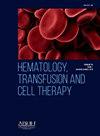INFLUENCE OF CD36 RS3211938 POLYMORPHISM ON HDL LEVELS IN BRAZILIAN SICKLE CELL ANEMIA PATIENTS
IF 1.8
Q3 HEMATOLOGY
引用次数: 0
Abstract
Introduction
Patients with sickle cell anemia (SCA) often exhibit reduced levels of high-density lipoprotein (HDL), which may be attributed to factors such as chronic inflammation, hemolysis, and oxidative stress. The CD36 gene, particularly the SNP rs3211938, regulates fatty acid metabolism and has been shown in other conditions, such as diabetes mellitus, to affect HDL levels. Alterations in lipid profiles and HDL functionality may potentially increase cardiovascular risk in individuals with SCA.
Objective
This study aimed to investigate whether CD36 gene polymorphisms influence HDL levels in SCA patients.
Material and methods
A Brazilian cohort of 190 patients with SCA was included, comprising 92 men and 98 women, with a mean age of 25.5 years (ranging from 15 to 56 years). All participants were confirmed as HbSS through high-performance liquid chromatography and molecular analysis. DNA was extracted from leukocytes obtained from total blood using the phenol/chloroform method. Genotyping of the CD36 gene was performed using the TaqMan assay. The association between genotypes and HDL levels was assessed using analysis of variance (ANOVA) to identify significant differences in HDL levels among different genotypes. Tukey's multiple comparison test was subsequently applied to determine which genotype pairs showed significant differences in HDL levels. All statistical analyses were conducted using RStudio, with the significance level set at p < 0.05.
Results
Genotyping revealed that 171 individuals carried the wild-type allele TT, 4 carried the mutant allele GG, and 15 carried the TG allele. Hardy-Weinberg equilibrium analysis showed allele frequencies of 0.93 for TT and 0.07 for GG, with a Chi2value of 17.7. ANOVA demonstrated a significant difference in HDL levels among the genotypes (F(2, 105) = 4.163, p = 0.0182). Tukey's test revealed that the mean difference in HDL levels between the TG and GG genotypes was 300.75, with a 95% confidence interval (CI) ranging from 20.42 to 581.08, indicating a significant difference (p = 0.0324). However, no significant differences were observed in HDL levels between the TT and GG genotypes (mean difference of 173.78; 95% CI: -79.50 to 427.05; p = 0.2371) or between the TT and TG genotypes (mean difference of -126.97; 95% CI: -257.36 to 3.41; p = 0.0580).
Discussion
The observed increase in HDL levels in individuals with the TG genotype may indicate a positive modulation of HDL functionality, which is particularly relevant for the SCA population given their predisposition to an adverse lipid profile and increased cardiovascular risk. The lack of significant differences in HDL levels between the TT and GG genotypes or the TT and TG genotypes suggests that the presence of the G allele, even in heterozygosity, may be sufficient to positively influence HDL levels. These findings align with previous studies implicating CD36 polymorphisms in altering lipid levels, particularly HDL, in other clinical conditions.
Conclusion
Our findings suggest that the rs3211938 polymorphism in the CD36 gene may play a significant role in determining HDL levels in SCA patients, particularly by increasing levels in individuals with the TG genotype. This discovery may have important implications for clinical management and the development of therapeutic strategies aimed at improving lipid profiles and reducing cardiovascular risk in this specific patient population.
cd36 rs3211938 多态性对巴西镰状细胞贫血症患者高密度脂蛋白水平的影响
导言镰状细胞性贫血(SCA)患者通常表现出高密度脂蛋白(HDL)水平降低,这可能是由于慢性炎症、溶血和氧化应激等因素造成的。CD36 基因,尤其是 SNP rs3211938,调节脂肪酸代谢,在糖尿病等其他疾病中已被证明会影响高密度脂蛋白水平。本研究旨在调查 CD36 基因多态性是否会影响 SCA 患者的高密度脂蛋白水平。材料和方法纳入了 190 名 SCA 患者的巴西队列,其中包括 92 名男性和 98 名女性,平均年龄为 25.5 岁(15 至 56 岁不等)。所有参与者均通过高效液相色谱法和分子分析确认为 HbSS。采用苯酚/氯仿法从全血中提取白细胞中的 DNA。采用 TaqMan 分析法对 CD36 基因进行基因分型。采用方差分析(ANOVA)评估基因型与高密度脂蛋白水平之间的关系,以确定不同基因型之间高密度脂蛋白水平的显著差异。随后采用 Tukey 多重比较检验来确定哪些基因型对的 HDL 水平存在显著差异。结果基因分型显示,171 人携带野生型等位基因 TT,4 人携带突变型等位基因 GG,15 人携带等位基因 TG。哈代-温伯格平衡分析显示,TT 的等位基因频率为 0.93,GG 的等位基因频率为 0.07,Chi2 值为 17.7。方差分析显示,不同基因型之间的高密度脂蛋白水平存在显著差异(F(2, 105) = 4.163, p = 0.0182)。Tukey检验显示,TG和GG基因型之间高密度脂蛋白水平的平均差异为300.75,95%置信区间(CI)为20.42至581.08,表明差异显著(p = 0.0324)。然而,TT 和 GG 基因型之间(平均差异为 173.78;95% CI:-79.50 至 427.05;p = 0.2371)或 TT 和 TG 基因型之间(平均差异为 -126.97;95% CI:-257.36 至 3.41;p = 0.0580)的高密度脂蛋白水平没有观察到明显差异。讨论在 TG 基因型个体中观察到的高密度脂蛋白水平的增加可能表明高密度脂蛋白功能的积极调节,这与 SCA 群体尤其相关,因为他们容易出现不良血脂状况并增加心血管风险。TT 和 GG 基因型之间或 TT 和 TG 基因型之间的高密度脂蛋白水平没有明显差异,这表明即使是杂合子,G 等位基因的存在也足以对高密度脂蛋白水平产生积极影响。我们的研究结果表明,CD36 基因中的 rs3211938 多态性可能在决定 SCA 患者的高密度脂蛋白水平方面起着重要作用,尤其是通过增加 TG 基因型个体的高密度脂蛋白水平。这一发现可能会对临床管理和治疗策略的开发产生重要影响,从而改善这一特殊患者群体的血脂状况并降低心血管风险。
本文章由计算机程序翻译,如有差异,请以英文原文为准。
求助全文
约1分钟内获得全文
求助全文
来源期刊

Hematology, Transfusion and Cell Therapy
Multiple-
CiteScore
2.40
自引率
4.80%
发文量
1419
审稿时长
30 weeks
 求助内容:
求助内容: 应助结果提醒方式:
应助结果提醒方式:


